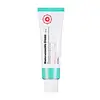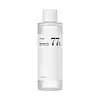What's inside
What's inside
 Key Ingredients
Key Ingredients

No key ingredients
 Benefits
Benefits

 Concerns
Concerns

No concerns
 Ingredients Side-by-side
Ingredients Side-by-side

Centella Asiatica Leaf Water
Skin ConditioningWater
Skin ConditioningCyclopentasiloxane
EmollientPropanediol
SolventPhenyl Trimethicone
Skin ConditioningGlycerin
HumectantPEG-10 Dimethicone
Skin ConditioningNiacinamide
SmoothingCyclohexasiloxane
EmollientPanthenol
Skin ConditioningEthoxydiglycol
HumectantDisteardimonium Hectorite
StabilisingSodium Chloride
MaskingRubus Suavissimus Leaf Extract
Skin ConditioningCentella Asiatica Extract
CleansingCaprylyl Glycol
EmollientPinus Densiflora Leaf Extract
AntimicrobialHamamelis Virginiana Leaf Extract
Skin ConditioningDimethicone Crosspolymer
Emulsion StabilisingCamellia Sinensis Leaf Extract
AntimicrobialButylene Glycol
HumectantMadecassoside
AntioxidantPentylene Glycol
Skin ConditioningCaprylhydroxamic Acid
Adenosine
Skin ConditioningLactic Acid
BufferingSodium Lactate
BufferingUrea
BufferingSerine
MaskingDisodium EDTA
Sorbitol
HumectantCitrus Grandis Peel Oil
MaskingAsiaticoside
AntioxidantCitrus Limon Peel Oil
MaskingPelargonium Graveolens Flower Oil
MaskingLavandula Hybrida Oil
EmollientJuniperus Mexicana Oil
MaskingCitrus Nobilis Peel Oil
MaskingAllantoin
Skin ConditioningChlorphenesin
AntimicrobialPhenoxyethanol
PreservativeCentella Asiatica Leaf Water, Water, Cyclopentasiloxane, Propanediol, Phenyl Trimethicone, Glycerin, PEG-10 Dimethicone, Niacinamide, Cyclohexasiloxane, Panthenol, Ethoxydiglycol, Disteardimonium Hectorite, Sodium Chloride, Rubus Suavissimus Leaf Extract, Centella Asiatica Extract, Caprylyl Glycol, Pinus Densiflora Leaf Extract, Hamamelis Virginiana Leaf Extract, Dimethicone Crosspolymer, Camellia Sinensis Leaf Extract, Butylene Glycol, Madecassoside, Pentylene Glycol, Caprylhydroxamic Acid, Adenosine, Lactic Acid, Sodium Lactate, Urea, Serine, Disodium EDTA, Sorbitol, Citrus Grandis Peel Oil, Asiaticoside, Citrus Limon Peel Oil, Pelargonium Graveolens Flower Oil, Lavandula Hybrida Oil, Juniperus Mexicana Oil, Citrus Nobilis Peel Oil, Allantoin, Chlorphenesin, Phenoxyethanol
Houttuynia Cordata Extract 77%
Skin ConditioningWater
Skin Conditioning1,2-Hexanediol
Skin ConditioningGlycerin
HumectantBetaine
HumectantPanthenol
Skin ConditioningSaccharum Officinarum Extract
MoisturisingPortulaca Oleracea Extract
Skin ConditioningButylene Glycol
HumectantVitex Agnus-Castus Extract
AstringentChamomilla Recutita Flower Extract
MaskingArctium Lappa Root Extract
Skin ConditioningPhellinus Linteus Extract
Skin ConditioningVitis Vinifera Fruit Extract
Skin ConditioningPyrus Malus Fruit Extract
Skin ConditioningCentella Asiatica Extract
CleansingIsopentyldiol
HumectantMethylpropanediol
SolventAcrylates/C10-30 Alkyl Acrylate Crosspolymer
Emulsion StabilisingTromethamine
BufferingDisodium EDTA
Houttuynia Cordata Extract 77%, Water, 1,2-Hexanediol, Glycerin, Betaine, Panthenol, Saccharum Officinarum Extract, Portulaca Oleracea Extract, Butylene Glycol, Vitex Agnus-Castus Extract, Chamomilla Recutita Flower Extract, Arctium Lappa Root Extract, Phellinus Linteus Extract, Vitis Vinifera Fruit Extract, Pyrus Malus Fruit Extract, Centella Asiatica Extract, Isopentyldiol, Methylpropanediol, Acrylates/C10-30 Alkyl Acrylate Crosspolymer, Tromethamine, Disodium EDTA
 Reviews
Reviews

Ingredients Explained
These ingredients are found in both products.
Ingredients higher up in an ingredient list are typically present in a larger amount.
Butylene Glycol (or BG) is used within cosmetic products for a few different reasons:
Overall, Butylene Glycol is a safe and well-rounded ingredient that works well with other ingredients.
Though this ingredient works well with most skin types, some people with sensitive skin may experience a reaction such as allergic rashes, closed comedones, or itchiness.
Learn more about Butylene GlycolCentella Asiatica Extract (Centella) is derived from an herb native to Southeast Asia. It is famous for its anti-inflammatory and soothing properties.
Centella is rich in antioxidants and amino acids, such as Madecassic Acid and Asiaticoside.
Studies show the compounds in centella help with:
The combination of all these properties makes centella effective at soothing, hydrating, and protecting the skin.
Other great components of centella include Vitamin A, vitamin C, several B vitamins, and Asiatic Acid.
Fun fact: Centella has been used as a medicine and in food for many centuries. As a medicine, it is used to treat burns, scratches, and wounds.
Learn more about Centella Asiatica ExtractDisodium EDTA plays a role in making products more stable by aiding other preservatives.
It is a chelating agent, meaning it neutralizes metal ions that may be found in a product.
Disodium EDTA is a salt of edetic acid and is found to be safe in cosmetic ingredients.
Learn more about Disodium EDTAGlycerin is already naturally found in your skin. It helps moisturize and protect your skin.
A study from 2016 found glycerin to be more effective as a humectant than AHAs and hyaluronic acid.
As a humectant, it helps the skin stay hydrated by pulling moisture to your skin. The low molecular weight of glycerin allows it to pull moisture into the deeper layers of your skin.
Hydrated skin improves your skin barrier; Your skin barrier helps protect against irritants and bacteria.
Glycerin has also been found to have antimicrobial and antiviral properties. Due to these properties, glycerin is often used in wound and burn treatments.
In cosmetics, glycerin is usually derived from plants such as soybean or palm. However, it can also be sourced from animals, such as tallow or animal fat.
This ingredient is organic, colorless, odorless, and non-toxic.
Glycerin is the name for this ingredient in American English. British English uses Glycerol/Glycerine.
Learn more about GlycerinPanthenol is a common ingredient that helps hydrate and soothe the skin. It is found naturally in our skin and hair.
There are two forms of panthenol: D and L.
D-panthenol is also known as dexpanthenol. Most cosmetics use dexpanthenol or a mixture of D and L-panthenol.
Panthenol is famous due to its ability to go deeper into the skin's layers. Using this ingredient has numerous pros (and no cons):
Like hyaluronic acid, panthenol is a humectant. Humectants are able to bind and hold large amounts of water to keep skin hydrated.
This ingredient works well for wound healing. It works by increasing tissue in the wound and helps close open wounds.
Once oxidized, panthenol converts to pantothenic acid. Panthothenic acid is found in all living cells.
This ingredient is also referred to as pro-vitamin B5.
Learn more about PanthenolWater. It's the most common cosmetic ingredient of all. You'll usually see it at the top of ingredient lists, meaning that it makes up the largest part of the product.
So why is it so popular? Water most often acts as a solvent - this means that it helps dissolve other ingredients into the formulation.
You'll also recognize water as that liquid we all need to stay alive. If you see this, drink a glass of water. Stay hydrated!
Learn more about Water